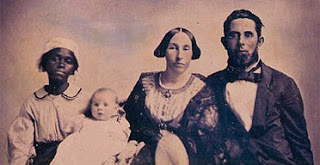
This short book is Mary Prince’s account of her life as a slave in the West Indies and later in London at the beginning of the nineteenth century.
What struck me particularly in her account was the huge variability in quality of her life, which entirely depended on the whim of her owners. Obviously, at all times slavery is completely immoral, but in the first family to who she belongs she is treated quite well and expresses great affection for the children she looks after. However, when she is then sold, she is separated from her mother and siblings and goes to a very harsh couple. With them, she works incessantly, from before dawn to well past dark, and is beaten for even small infractions. Unfortunately she is then sold again, to an even worse family, who force her to work collecting salt. All the slaves have to stand in salt water all day, so they acquire terrible boils. Sometimes they have to work all night, in which case no alteration is made; they still have to work all the next day. This couple then takes her to England with them when they go their on a visit. Now apparently at this time slavery was illegal in England, but legal in the colonies, so she is theoretically free to leave at any time. It struck me as very odd that her owners did not think she would leave, but curiously she does not for many months, until their treatment becomes so terrible that she goes to see some of the abolitionist activists, who assist her to leave. Her previous owner bizarrely then tries to blacken her name, so she can get no other employment and will be forced to come back to him. Even more weirdly, when he is offered her full price for her freedom (so she can go back to Antigua and be there free also), he refuses this too, presumably out of malice.
This book has a lengthy preface, in which the abolitionist who assisted her tries to convince the British public of the honesty of her words and the importance of total abolition across the Empire. It was very interesting to see what were the real debates of the period. It appears that many people did not believe that such awful things could possibly be happening. For example, Mary tells us that one of the old men was tortured by the owner, who kept throwing extra salt in his wounds so he would never heal. He didn’t do this to the other slaves. You can see where this seems so unimaginably horrible that you might doubt it’s reality, and he spends much of the pamphlet explaining that slavery brutalizes owners also. I find it interesting, just by the by, how little one hears about the efforts of abolitionists, which was after all really key to ending slavery. Perhaps, as they were mostly religious people, it is because they are now unfashionable?
There are also a couple of pages at the end by a West African called Asa-Asa, who tells us how he was abducted. This is very sad. The neighbouring people set his village alight, and then returned over the course of about a month to capture any and everyone they could. He does not know what happened to his family as he hid in a tree and they kept running when their enemies came. It sounds pretty much exactly like what you hear about happening today in DRC. He also tells us he changed hands as a slave five or six times within Africa itself, before he was sold to a white person, which also says something pretty sad about slavery in Africa at the time.
